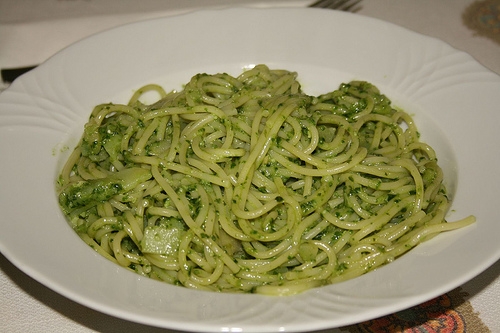Send your question to Umbra!
Q. Dear Umbra,
I am a fairly active, athletic person; that being said, I love my pasta. When I boil the water for my pasta, I run the tap water for about 5–10 seconds until the water becomes very hot, then fill up my pot, and set it on my glass-top stove to boil. The water seems to boil almost instantaneously when I fill it up with hot water, and when I fill it up from the tap right away with cooler water, it takes longer. So, my question is: Is it more wasteful to let the precious water run to get hot for 5–10 seconds, reducing the boiling time? Or is it more wasteful to fill it up with cooler water, not wasting any water, but using more electricity to boil the water? One other consideration is that I live at high altitude, and water takes longer to boil here. Thanks so much!
Nate W.
Redmond, Ore.
A. Dearest Nate,
 Photo: lucadea via FlickrYou know, I actually dropped a few pounds on a pasta diet once. I just had to walk pasta the refrigerator, pasta the bakery, and pasta the ice cream shop. A 3-year-old told me that joke.
Photo: lucadea via FlickrYou know, I actually dropped a few pounds on a pasta diet once. I just had to walk pasta the refrigerator, pasta the bakery, and pasta the ice cream shop. A 3-year-old told me that joke.
But you know what’s really nothing to laugh at (besides my pasta joke)? Wasting our precious resources. Cooking noodles is one of those small things I’m always telling you not to sweat; but conserving water and energy is a big honking thing to sweat, so I’m happy to fill you in. Plus, it gives me a chance to play around in the Grist test kitchen.
Since I have some better solutions to come, let’s go ahead and take the letting-water-run-until-it’s-hot option off the table right now. After space heat—that is, heating your entire home—water heaters are the largest household energy consumers. And there are more efficient means of heating such a small amount of water that also don’t let natural resources just run down the drain (I don’t suppose you had a bucket there each time to catch excess water?).
So does that just leave us waiting for the recommended six quarts of cooler tap water to boil on the stovetop before adding our pasta? Not necessarily. First off, you do not—I repeat, do not—need six quarts of water to make a bowl of pasta. Yes, I know that’s what it says on the box. Grist’s own food guru, Tom Philpott, and food-science writer Harold McGee both concur that six quarts are overkill. About a quart and a half should do the trick (I actually used even less for mine).
Secondly, here’s the real coup: You can put the pasta right into the cold water! That’s right. You don’t need to boil the water first. Pop your pasta in, put a lid on the pot (contains the heat), and stir as needed to prevent sticking. This method produced the same delectable rotini for me as the boil-first method, saving water (ta-ta, six quarts) and energy, and it was really no extra effort.
I wasn’t satisfied to stop there, though, as I wanted to give you options, plural. I’m not sure how the cold water method works at high altitude, or if there’s any difference at all, but let’s say you decide to stick with the boil-first method. We know from my previous column on boiling water for tea that the electric kettle is No. 1 in water-heating efficiency. Thusly, how about getting your pasta water started in an electric kettle? Once it’s boiling (or nearly boiling) pour it over your pasta in a pot, and then pop the lid on. Turn the burner on to keep the water’s momentum going, and voila. Cooked pasta in 10 minutes (or however long your particular type of pasta takes)—which reminds me of yet another energy-saving tip: You don’t have to leave the stove on for the duration of the cooking time. Turn off the burner a few minutes before the pasta is finished, leaving the lid on. The pasta will continue to cook in the pot.
And don’t just toss that water post-cooking. Pasta water in restaurants is liquid gold—used as a sauce thickener. While you may not be able to replicate the starchy water made from boiling order after order of spaghetti, you can still try mixing some pasta water in with your next batch of homemade tomato sauce. Or you can just let the water cool to room temperature and use it to give your houseplants a little hydration.
Saucily,
Umbra
Other helpful links:
Ask Umbra on water conservation
Ask Umbra on boiling water for tea
Ask Umbra on water heaters
Ask Umbra on waiting for warm water
Q. Dear Umbra,
My granddaughter uses Clorox Disinfecting Wipes constantly on everything. She has a 2-year-old son, who is asthmatic and seems to have a somewhat compromised immune system. The least little trigger can set him off into an asthma attack, which on occasion has developed into pneumonia and resulted in hospital stays. She is obsessed with certain hygiene, and I tend to think she overdoes it. Plus, she tends not to wipe off the kitchen counters with a dishrag before she uses the wipes, which leaves scum on the counters. Please help me with recommendations I can pass on to her. Thanks!
Carol J.
Scottsdale, Ariz.
A. Dearest Carol,
Advising loved ones on child-rearing or cleaning techniques is a slippery slope indeed, as is giving this question a definitive answer.
Let’s first start by breaking down what exactly is in these wipes. A couple of the key ingredients are alkyl dimethyl benzyl ammonium chloride and alkyl dimethyl ethylbenzyl ammonium chloride (whew, glad I didn’t get those words in my fourth grade spelling bee). The production of these compounds results in harmful dioxins, which can cause cancer, immune system problems, and reproductive issues. Additionally, the ingredients themselves can cause skin irritation, headaches, and respiratory issues. In short, these chems are not a good thing to have around a child who’s already having his share of breathing problems, methinks.
Plus, these wipes are utterly disposable, equaling a lot of unnecessary waste. One swipe, and then into the trash bin—sad. Not to mention the fact that they are packaged in a plastic bottle, which is a big petroleum-sucking no-no in my book.
I’m not a doctor and don’t even pretend to play one in this column (though I do look mighty authoritative wearing a stethoscope), so I’m not going to try to diagnose whether your great-grandson’s condition warrants the kind of disinfection these wipes offer, harsh though their ingredients may be. Try referring his mom to my April 12 column on sanitizing counters with white vinegar and hydrogen peroxide (in two separate bottles). The combo kills almost all Salmonella, Shigella, and E. coli bacteria. However, if whiter, grime-free surfaces are all your granddaughter is after, then our friends vinegar, baking soda, and castile soap along with a reusable dishcloth and a little elbow grease should do the trick.
Spotlessly,
Umbra
Other helpful links:
Ask Umbra on bleach
Ask Umbra on green cleaning
Ask Umbra on having kids
Ask Umbra on mini-dilemmas
In my April 5 column, I responded to 9-year-old Ian’s question about eco-friendly packaging for his newly designed card game. In return, I received a package this week with a handmade thank-you card from Ian, a lovely letter from his mom, and pictures of Ian and his completed product, which I wanted to share with you guys.
 Ian, rocking a rad fedora and showing off his upcycled game packaging.Hello! I wanted to say thanks, because your ideas really helped! My updated format looks great, and it’s eco-friendly, not to mention cheap. Here are some pictures for you to enjoy.
Ian, rocking a rad fedora and showing off his upcycled game packaging.Hello! I wanted to say thanks, because your ideas really helped! My updated format looks great, and it’s eco-friendly, not to mention cheap. Here are some pictures for you to enjoy.
Ian
Dear Umbra,
Several weeks ago, you answered my 9-year-old son’s question about creating eco-friendly packaging for a game he’s invented. Your reply thrilled him—he was surprised that he got a reply. It made his day. He ended up rethinking his packaging and created drawstring bags out of a variety of leftover fabrics. It significantly lowered his costs, taught him sewing skills, and added an element of personalization to each game. And eco-friendly to boot!
Many thanks from a grateful mom,
Gwyn R.


